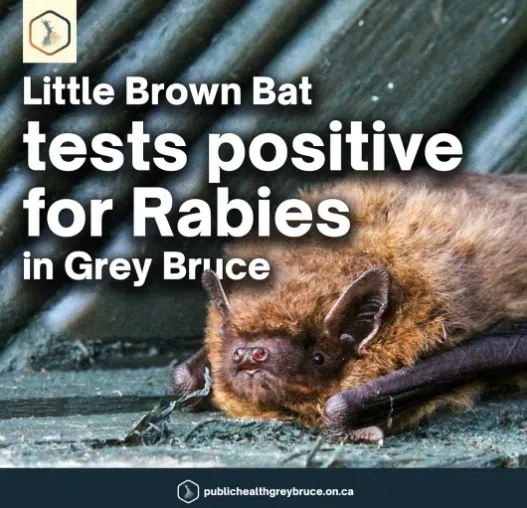Public Health Grey Bruce says a little brown bat has tested positive for rabies in the region.
They say it was submitted earlier this week, and test results received on Wednesday, July 24th show it had rabies.
They say the test was submitted as part of an investigation into possible human exposure, and the person involved is receiving post-exposure rabies treatment in order to ensure they don’t the virus.
They say “Once symptoms appear, the rabies virus is virtually 100% fatal in people and animals. However, rabies vaccines are highly effective at preventing the disease if administered before symptoms occur.”
They say it’s the first known case in an animal in Grey Bruce this year.
Andrew Barton, a Senior Public Health Manager and manager of the health unit’s Environmental Health program says, “While the risk of acquiring rabies locally remains very low, this case confirms the presence of the rabies virus in Grey-Bruce and highlights the importance of avoiding contact with wildlife and taking other steps to prevent animal bites and scratches.”
Public Health says rabies is usually transmitted to humans through direct contact with saliva from an infected animal, such as through a bite or, less commonly, a scratch.
Bats, skunks, foxes, and raccoons are the most common animals to have rabies in Ontario.
Public Health says people should avoid petting or touching wildlife.
They say not to approach or feed wild animals. Keep pets away from them, and get your pets vaccinated against rabies. They say you should wildlife proof homes and cottages. Public health advises people not to disturb baby animals and they warn against trapping or transporting wild animals to a new location.
They say you can bat-proof your home or cottage by caulking holes in the exterior, even those as small as one-quarter to one-half inch in diameter, tightening screens, capping your chimney, placing draft guards under doors leading to the attic and outside, and filling plumbing fixture holes with steel wool or caulk.
They also note, human cases of rabies are very rare in Ontario, with the province’s last domestic case of human rabies occurring in 1967.
They add, in 2023, there were 56 confirmed wildlife rabies cases in Ontario, with the vast majority involving bats.
It’s been 15 years since a non-flying animal has tested positive for rabies in Grey-Bruce.
Grey Bruce Public Health conducted 592 potential rabies exposure investigations in 2023.
They say about two-thirds of the investigations followed a dog bite, while 130 were linked to a cat bite or scratch and 21 involved a human-wildlife interaction.
Grey Bruce Public Health also advises people to take steps to prevent bites from unfamiliar dogs.
Call the Wildlife Health Information Line at 1-888-574-6656 for information about how to report a suspected rabid animal or visit the Ontario government’s Rabies Webpage.






